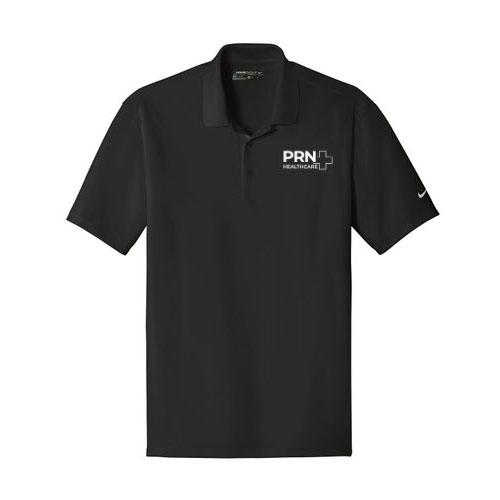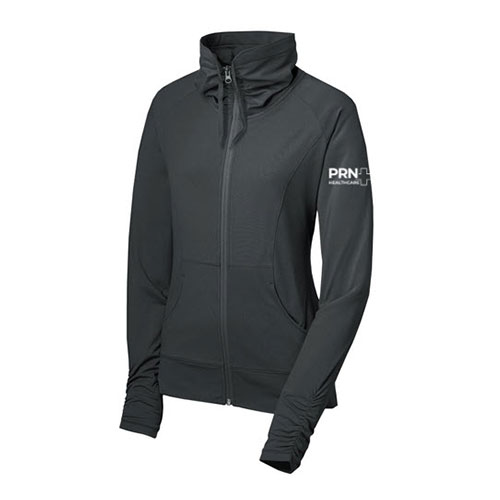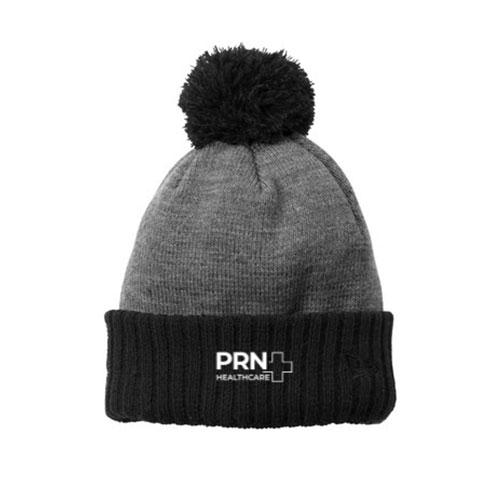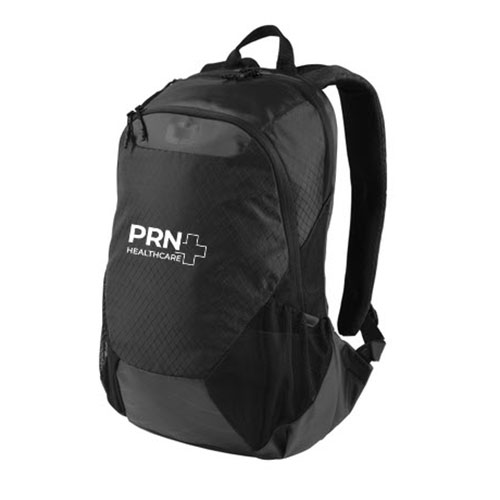Table of Contents
Travel Nurse Resume ExampleCrafting an Effective Layout for Your Travel Nurse Resume#1 Contact Information#2 Objective#3 License and Certification#4 Work Experience#5 Professional Skill#6 Qualifications#7 Accomplishments#8 EducationComparison of Good and Bad Travel Nurse ResumesPros and Cons of a Travel Nurse Resume5 Tips to Improve a Travel Nurse Resume#1 Customize Your Summary#2 Use Action Verbs in Your Experience Section#3 Don’t Exaggerate Your Experience#4 Write for a Computer#5 Check Spelling and Grammar TwiceWhat is the Right Resume Format for Travel Nurses?What is the Ideal Length for a Travel Nurse’s Resume?As a Healthcare staffing agency, we understand the importance of having reliable information and trustworthy information available to you. That’s why our healthcare content is created by experienced nurses and healthcare professionals who understand the industry firsthand. We use trustworthy sources and keep our information up-to-date so you can feel confident in the advice and resources we offer.
Creating a compelling travel nurse resume is essential for landing your dream assignments. This guide will provide valuable tips and examples to help you craft a winning resume. Plus, you can access a free template to kickstart your journey towards a successful nursing career.
Travel Nurse Resume Example
Crafting an Effective Layout for Your Travel Nurse Resume
Designing an appealing and organized layout for your travel nurse resume is crucial to making a strong first impression on potential employers. Every nurse’s resume should include these essential sections:
#1 Contact Information
✓ Your name and surname in legible and larger resume font
✓ The job title you are applying for or your current job title as a subheading to your name
✓ Link you to your LinkedIn profile
✓ Address (City and State for the US)
✓ Email address
✓ Phone Number
#2 Objective
The objective section introduces yourself and encapsulates what you seek in a future opportunity.
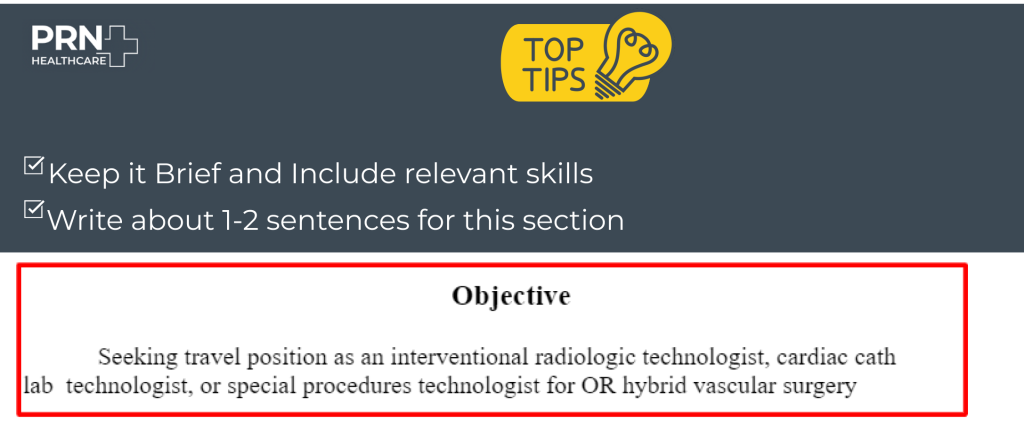
#3 License and Certification
State your license and all certifications you have received that are still active. Also, include your specialty in this section. Put dates next to all your certifications and when you received your license. This is helpful for them to know what credentials will be expiring or if you need to have things renewed before or during your contract.

#4 Work Experience
The work experience section of your travel nurse resume will make you stand out from other applicants. This section is arguably the most important for employers and dates of employment.
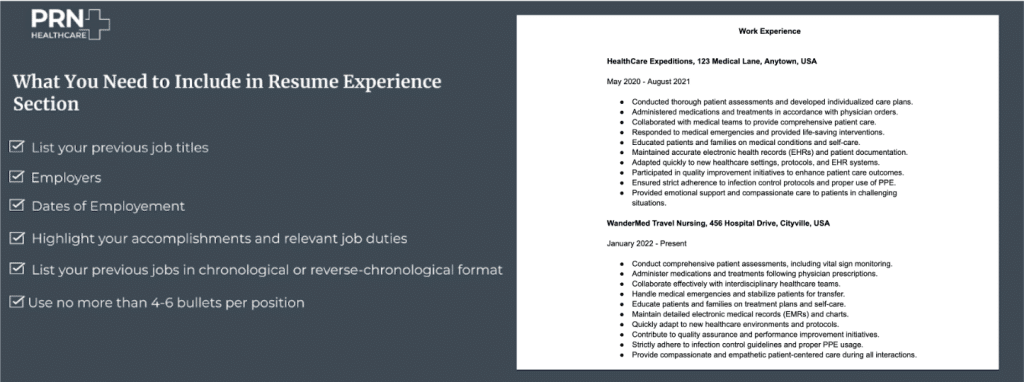
#5 Professional Skill
This section showcases the unique abilities and expertise that set you apart in nursing. Highlight your adaptability, technical skills, and experience in diverse medical environments to illustrate your readiness for the dynamic challenges of travel nursing.
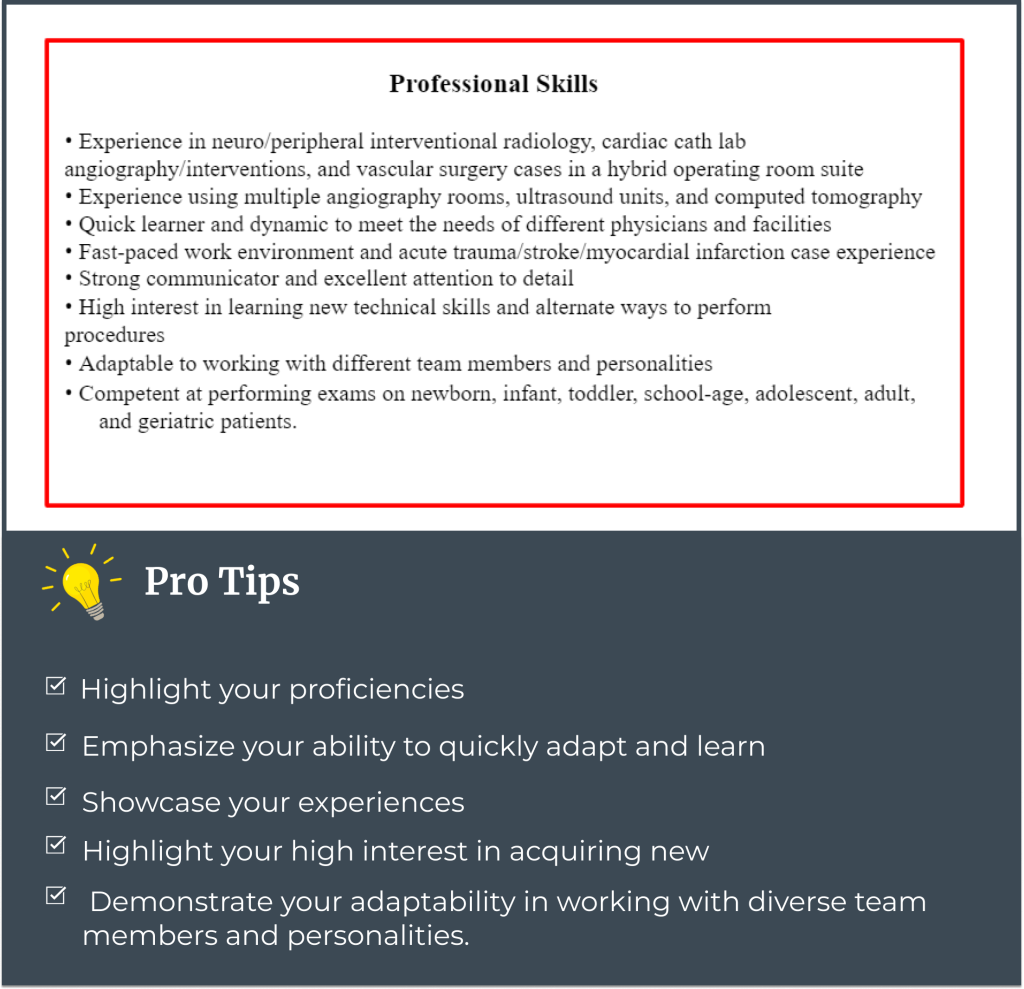
#6 Qualifications
As a travel nurse, your qualifications should reflect a deep understanding and hands-on experience in specialized medical procedures and technologies pertinent to your field. Whether it’s interventional radiology, cardiac cath lab procedures, or vascular surgery, highlight your proficiency with specific techniques like thrombectomy, stenting, and catheterization. Familiarity with various medical equipment and the ability to adapt to different technological environments is crucial. Also, showcase your competence in handling diverse patient care situations, ranging from routine procedures to emergency responses, indicating your readiness to effectively manage a broad spectrum of clinical scenarios. Good example below:
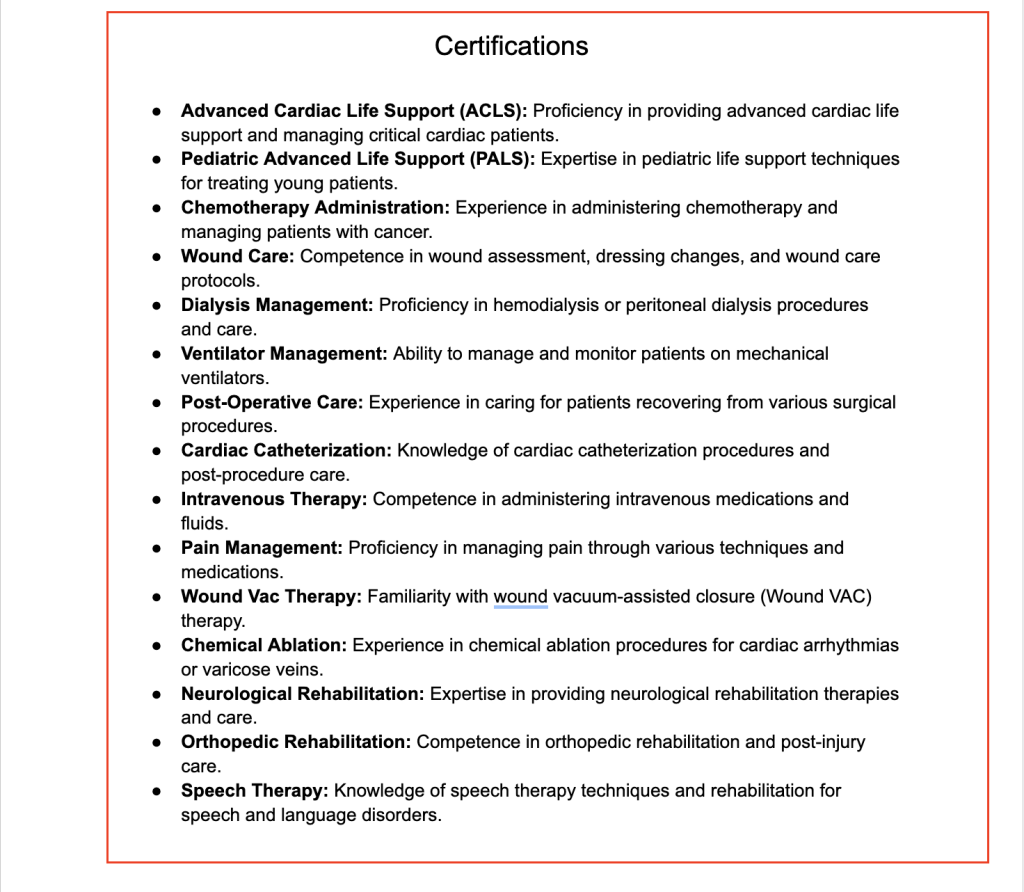
#7 Accomplishments
This section highlights vital achievements that demonstrate your exceptional skills and contributions to the nursing field. This section showcases measurable successes and recognitions, underlining your professional excellence and dedication.
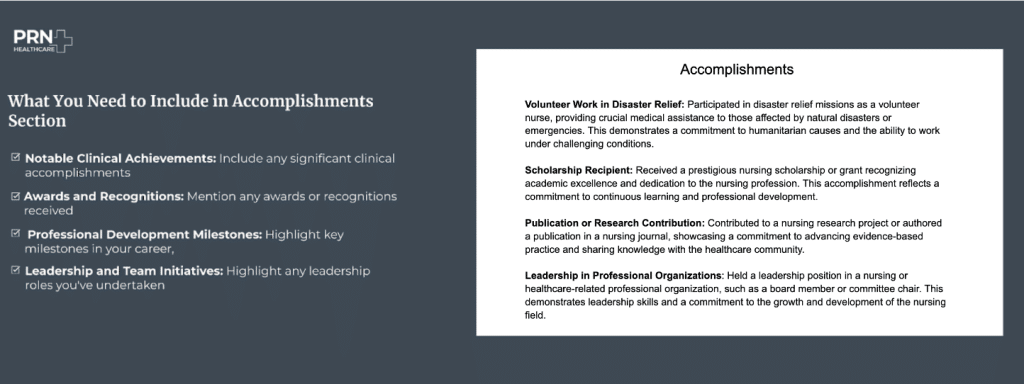
#8 Education
In the education section, list your degrees and diplomas with dates. If you are a new graduate, feel free to list other specialized skills you already have education in that other new grads may not.
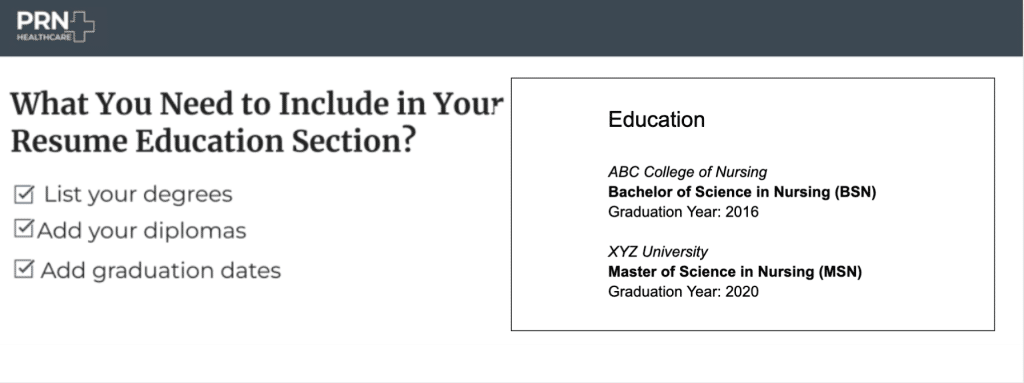
Comparison of Good and Bad Travel Nurse Resumes
In the table below, we have delineated the essential components of an effective travel nurse resume. Each element is crucial in conveying your qualifications and professional background to prospective employers.
Pros and Cons of a Travel Nurse Resume
| Key Components | Good Resume Example | Bad Resume Example |
|---|---|---|
| Contact Information | Clear listing of full name, phone number, professional email, and city/state of residence. | Missing/incorrect contact info, unprofessional email, or inclusion of unnecessary personal details. |
| Resume Summary | Concise summary stating experience, specialties, and career objectives, tailored to the specific position. | Vague/generic summary or no summary at all. |
| License Details | Clear listing of nursing licenses with state(s) of licensure and license numbers. | Missing/incomplete licensure info or failure to mention compact licensure. |
| Work Experience | Well-organized listing of relevant work experiences with facility, location, dates. | Disorganized/incomplete work experience section or listing irrelevant jobs. |
| Education | Clear listing of nursing education with relevant coursework or clinical rotations. | Missing/unclear education info or failing to list important credentials. |
| Certifications | Detailed listing of relevant certifications with dates of attainment and expiration. | Missing/incomplete certification info or listing outdated/irrelevant certifications. |
5 Tips to Improve a Travel Nurse Resume
Selecting the appropriate resume format is the first crucial step in crafting a travel nurse resume that effectively communicates your skills and experience.
#1 Customize Your Summary
As tempting as it is to submit your same resume to a handful of jobs, customizing your summary to the specific job and facility goes a long way. This is one of the first sections a hiring manager sees before looking at the rest of the resume. This section should give them a taste of what is to come. When writing your summary, you’ll want to mention the specific position and the facility name so it feels personable. In this section, give your personal statement, a brief overview of your professional skills, and a synopsis of your career thus far. Here is an example:
I am enthusiastically applying to be an Intensive Care Unit Registered Nurse at PRN Healthcare. I am looking for travel nurse opportunities and am open to location. My six years of experience in the ICU has given me great experience in patient care, communicating effectively, and working under pressure. I am confident I would be a great asset to the team at PRN Healthcare!
#2 Use Action Verbs in Your Experience Section
Using action words in your experience section will add dimension and momentum. Instead of saying, “I planned patient care with team members,” use the phrase, “Collaborated with team members on patient care plans.” Your experience section should not be a long paragraph of sentences but a bulleted list of your experiences.
#3 Don’t Exaggerate Your Experience
The number one way to frustrate your interviewers is to exaggerate your experience. This is dangerous for you and a waste of time for interviewers. The agency or hiring managers select travel nurse resumes based on what they need based on experience and certifications. If you exaggerate your experience, you could be expected to carry out responsibilities you are not trained for. This could cause costly medical errors. If the interviewers find out you lied on your resume during their interview, that can leave a bad impression, especially if you apply for other jobs through them later. Always air on the safe side, and don’t exaggerate your experience.
#4 Write for a Computer
Travel nurse resumes may be run through a computer at large hospital systems or agencies to weed out good and bad candidates. The trick to having the computer select your resume over others is the keywords you use. Review the job description and try to match key phrases and words to what is in the job description. For example, if the job description says, “Record patient vital signs and medical information accurately and in detail,” you can write in your experience section, “Recorded patient vital signs and information with close attention to detail.” These phrases are close enough together that the computer will pick them up as a match!
#5 Check Spelling and Grammar Twice
We understand this is a travel nurse resume, and you are not applying to be a book editor, but having great grammar and spelling will be a great sign for employers. After all, written and verbal communication is a huge part of being a successful registered nurse. We all make grammatical errors now and again, especially if you have been staring at your resume for a long time. A rule of thumb is to take a break and come back to review your resume later. Also, send your travel nurse resume to a trusted friend or family member to proof it to you.
What is the Right Resume Format for Travel Nurses?
Creating a well-structured and professionally formatted travel nurse resume is essential to make a strong first impression on potential employers and enhance your chances of landing the assignments you desire
- Font Type and Size: Use a clean, professional, and easy-to-read font such as Arial, Calibri, or Times New Roman.
- Keep your font size between 10 and 12 points for the main content. Use a slightly larger size for your name and section headings to make them stand out.
- Consistency: Maintain consistent formatting throughout your resume. This includes using the same font, size, and style for headings, subheadings, and content.
- Bullet Points: Use bullet points to organize information. This makes your resume easier to scan and read.
- Margins: Set one-inch margins on all sides of the page to ensure your resume has a clean and professional look.
- Images and Graphics: Avoid adding images, graphics, or icons to your resume. Most applicant tracking systems (ATS) may not recognize or process these elements, potentially causing issues with resume parsing.
- Color Usage: Stick to a black-and-white color scheme for the main content of your resume. This is the most widely accepted and professional format.
- You can use a subtle pop of color for headings or section dividers, but ensure it remains minimal and doesn’t distract from the content.
- Bold and Italics: Use bold text for section headings and to emphasize key points.
- Italics can be used for job titles, certifications, or other secondary information.
- Whitespace: Allow for ample white space between sections and around text to make your resume visually appealing and easy to read.
- Alignment: Maintain a consistent alignment throughout your resume. Typically, a left-aligned format is preferred.
- File Format: Save your resume as a PDF to preserve formatting across different devices and operating systems. This ensures your resume will appear as intended to employers.
By following these formatting guidelines, you’ll create a professional and visually appealing travel nurse resume that is more likely to capture the attention of potential employers and pass through automated applicant tracking systems with ease.
What is the Ideal Length for a Travel Nurse’s Resume?
The ideal length for a travel nurse resume is one to two pages. This length strikes a balance between providing enough information to showcase your qualifications effectively and keeping the document concise and reader-friendly. As travel nurses often have diverse experiences, keeping the resume within this range ensures that you include all relevant details without overwhelming potential employers with an overly lengthy document.
However, it’s essential to note that there can be exceptions to this general guideline. A two-page resume may be warranted for seasoned travel nurses with extensive experience. Conversely, entry-level nurses or those with limited experience should aim for a succinct one-page resume. Ultimately, the goal is to present a resume that is comprehensive yet focused on the most relevant information, ensuring it is easy for employers to assess your qualifications quickly.


